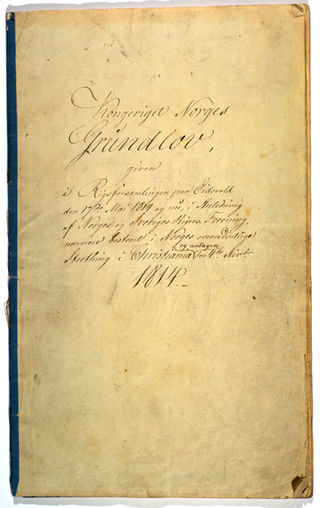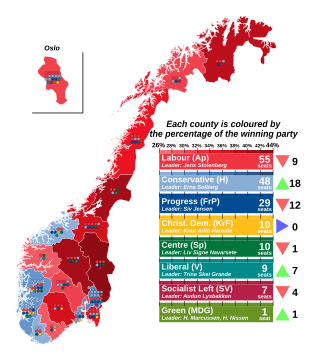
The Constitution of Norway was adopted on 16 May and signed on 17 May 1814 by the Norwegian Constituent Assembly at Eidsvoll. The latter date is the National Day of Norway; it marks the establishment of the constitution.

The Storting is the supreme legislature of Norway, established in 1814 by the Constitution of Norway. It is located in Oslo. The unicameral parliament has 169 members and is elected every four years based on party-list proportional representation in nineteen multi-seat constituencies. A member of the Storting is known in Norwegian as a stortingsrepresentant, literally "Storting representative".

Sweden and Norway or Sweden–Norway, officially the United Kingdoms of Sweden and Norway, and known as the United Kingdoms, was a personal union of the separate kingdoms of Sweden and Norway under a common monarch and common foreign policy that lasted from 1814 until its peaceful dissolution in 1905.

The Liberal Party is a centrist political party in Norway. It was founded in 1884 and it is the oldest political party in Norway. It is positioned in the centre on the political spectrum, and it is a liberal party which has over the time enacted reforms such as parliamentarism, freedom of religion, universal suffrage, and state schooling.

Parliamentary elections were held in Norway on 11 and 12 September 2005. The result was a victory for the opposition centre-left Red-Green Coalition, which received 48.0% of the votes and won 87 out of 169 seats, dominated by the Labour Party's 61 seats. The three-party centre-right government coalition won 44 seats and the right wing Progress Party won 38, becoming the largest opposition party. Voter turnout was 77.1%, an increase of 2 percentage points compared to the 2001 elections.

Parliamentary elections were held in Norway on 13 and 14 September 2009. Elections in Norway are held on a Monday in September, usually the second or third Monday, as determined by the king. Early voting was possible between 10 August and 11 September 2009, while some municipalities also held open voting on 13 September. Voters elected 169 members for the Storting, each for a four-year term. Voter turn-out in the 2009 general elections was 76.4%.
Nationwide local elections for seats in municipality and county councils were held throughout Norway on 12 September 2011. Several municipalities also opened the polling booths on 11 September. For polling stations this meant that two elections, the municipal elections and the county elections ran concurrently. In addition, an advisory referendum was held in Aust-Agder to determine whether to merge the county with Vest-Agder.
Parliamentary elections were held in Norway in 1829. As political parties were not officially established until 1884, all those elected were independents. The number of seats in the Storting was increased from 79 to 81. Voter turnout was 45%, although only 5.5% of the country's population was eligible to vote.
Parliamentary elections were held in Norway in 1835. As political parties were not officially established until 1884, all those elected were independents. The number of seats in the Storting was increased from 95 to 96. Voter turnout was 52%, although only 6% of the country's population was eligible to vote.
Parliamentary elections were held in Norway in 1841. As political parties were not officially established until 1884, all those elected were independents. The number of seats in the Storting was increased from 99 to 100. Voter turnout was 51%, although only 5.5% of the country's population was eligible to vote.
Parliamentary elections were held in Norway in 1844. As political parties were not officially established until 1884, all those elected were independents. The number of seats in the Storting was increased from 100 to 102. Voter turnout was 49%, although only 5% of the country's population was eligible to vote.
Parliamentary elections were held in Norway in 1847. As political parties were not officially established until 1884, all those elected were independents. The number of seats in the Storting was increased from 102 to 105. Voter turnout was 49%, although only 5% of the country's population was eligible to vote.
Parliamentary elections were held in Norway in 1850. As political parties were not officially established until 1884, all those elected were independents. The number of seats in the Storting was increased from 105 to 106. Voter turnout was 50%, although only 5% of the country's population was eligible to vote.
Parliamentary elections were held in Norway in 1853. As political parties were not officially established until 1884, all those elected were independents. The number of seats in the Storting was increased from 106 to 107. Voter turnout was 45%, although only 5% of the country's population was eligible to vote.
Parliamentary elections were held in Norway in 1862. As political parties were not officially established until 1884, all those elected were independents. The number of seats in the Storting was reduced from 117 to 111. Voter turnout was 45%, although only 5% of the country's population was eligible to vote.

Parliamentary elections were held in Norway on 8 and 9 September 2013 to elect all 169 members of the unicameral Storting. The centre-right coalition obtained 96 seats, while the incumbent red–green coalition government obtained 72 seats and the Green Party obtained one. The Labour Party won the largest share (30.8%) of the votes cast, with the Conservatives coming second (26.8%), after increasing its share by 9.6 percentage points.

Rasmus Johan Michael Hansson is a Norwegian biologist, civil servant, environmental activist and a former national spokesperson for the Green Party. He led the Norwegian chapter of World Wide Fund for Nature from 2000 to 2012. In 2013, he was elected to the Parliament of Norway as the first representative for the Green Party.

Parliamentary elections were held in Norway on 11 September 2017 to elect all 169 members of the unicameral Norwegian Parliament, the Storting. The non-socialist parties retained a reduced majority of 88 seats, allowing Prime Minister Erna Solberg's Conservative-Progress coalition to remain in government. The Liberal Party joined the coalition in January 2018 but it remained a minority cabinet until the Christian Democratic Party joined the coalition in 2019. The three largest centre-left parties won 79 seats. The Green Party retained its single seat, while the Red Party won its first ever seat.








